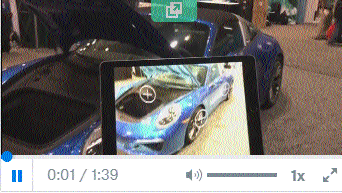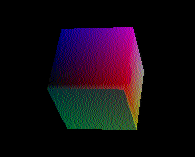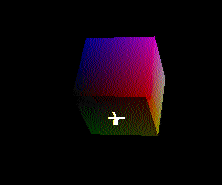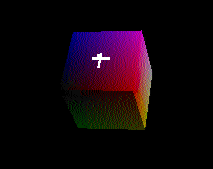I would like to create a shader like that that takes world coordinates and creates waves. I would like to analyse the video and know the steps that are required. I'm not looking for codes, I'm just looking for ideas on how to implement that using GLSL or HLSL or any other language.
Here low quality and fps GIF in case link broke.
Here is the fragment shader:
#version 330 core
// Interpolated values from the vertex shaders
in vec2 UV;
in vec3 Position_worldspace;
in vec3 Normal_cameraspace;
in vec3 EyeDirection_cameraspace;
in vec3 LightDirection_cameraspace;
// highlight effect
in float pixel_z; // fragment z coordinate in [LCS]
uniform float animz; // highlight animation z coordinate [GCS]
// Ouput data
out vec4 color;
vec3 c;
// Values that stay constant for the whole mesh.
uniform sampler2D myTextureSampler;
uniform mat4 MV;
uniform vec3 LightPosition_worldspace;
void main(){
// Light emission properties
// You probably want to put them as uniforms
vec3 LightColor = vec3(1,1,1);
float LightPower = 50.0f;
// Material properties
vec3 MaterialDiffuseColor = texture( myTextureSampler, UV ).rgb;
vec3 MaterialAmbientColor = vec3(0.1,0.1,0.1) * MaterialDiffuseColor;
vec3 MaterialSpecularColor = vec3(0.3,0.3,0.3);
// Distance to the light
float distance = length( LightPosition_worldspace - Position_worldspace );
// Normal of the computed fragment, in camera space
vec3 n = normalize( Normal_cameraspace );
// Direction of the light (from the fragment to the light)
vec3 l = normalize( LightDirection_cameraspace );
// Cosine of the angle between the normal and the light direction,
// clamped above 0
// - light is at the vertical of the triangle -> 1
// - light is perpendicular to the triangle -> 0
// - light is behind the triangle -> 0
float cosTheta = clamp( dot( n,l ), 0,1 );
// Eye vector (towards the camera)
vec3 E = normalize(EyeDirection_cameraspace);
// Direction in which the triangle reflects the light
vec3 R = reflect(-l,n);
// Cosine of the angle between the Eye vector and the Reflect vector,
// clamped to 0
// - Looking into the reflection -> 1
// - Looking elsewhere -> < 1
float cosAlpha = clamp( dot( E,R ), 0,1 );
c =
// Ambient : simulates indirect lighting
MaterialAmbientColor +
// Diffuse : "color" of the object
MaterialDiffuseColor * LightColor * LightPower * cosTheta / (distance*distance) +
// Specular : reflective highlight, like a mirror
MaterialSpecularColor * LightColor * LightPower * pow(cosAlpha,5) / (distance*distance);
float z;
z=abs(pixel_z-animz); // distance to animated z coordinate
z*=1.5; // scale to change highlight width
if (z<1.0)
{
z*=0.5*3.1415926535897932384626433832795; // z=<0,M_PI/2> 0 in the middle
z=0.5*cos(z);
color+=vec3(0.0,z,z);
}
color=vec4(c,1.0);
}
here is the vertex shader:
#version 330 core
// Input vertex data, different for all executions of this shader.
layout(location = 0) in vec3 vertexPosition_modelspace;
layout(location = 1) in vec2 vertexUV;
layout(location = 2) in vec3 vertexNormal_modelspace;
// Output data ; will be interpolated for each fragment.
out vec2 UV;
out vec3 Position_worldspace;
out vec3 Normal_cameraspace;
out vec3 EyeDirection_cameraspace;
out vec3 LightDirection_cameraspace;
out float pixel_z; // fragment z coordinate in [LCS]
// Values that stay constant for the whole mesh.
uniform mat4 MVP;
uniform mat4 V;
uniform mat4 M;
uniform vec3 LightPosition_worldspace;
void main(){
pixel_z=vertexPosition_modelspace.z;
// Output position of the vertex, in clip space : MVP * position
gl_Position = MVP * vec4(vertexPosition_modelspace,1);
// Position of the vertex, in worldspace : M * position
Position_worldspace = (M * vec4(vertexPosition_modelspace,1)).xyz;
// Vector that goes from the vertex to the camera, in camera space.
// In camera space, the camera is at the origin (0,0,0).
vec3 vertexPosition_cameraspace = ( V * M * vec4(vertexPosition_modelspace,1)).xyz;
EyeDirection_cameraspace = vec3(0,0,0) - vertexPosition_cameraspace;
// Vector that goes from the vertex to the light, in camera space. M is ommited because it's identity.
vec3 LightPosition_cameraspace = ( V * vec4(LightPosition_worldspace,1)).xyz;
LightDirection_cameraspace = LightPosition_cameraspace + EyeDirection_cameraspace;
// Normal of the the vertex, in camera space
Normal_cameraspace = ( V * M * vec4(vertexNormal_modelspace,0)).xyz; // Only correct if ModelMatrix does not scale the model ! Use its inverse transpose if not.
// UV of the vertex. No special space for this one.
UV = vertexUV;
}




